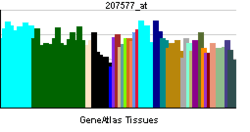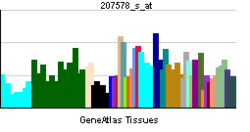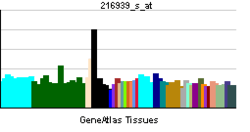5-HT4 receptor
| View/Edit Human | View/Edit Mouse |
5-Hydroxytryptamine receptor 4 is a protein that in humans is encoded by the HTR4 gene.[4][5]
Function
This gene is a member of the family of human serotonin receptors, which are G protein-coupled receptors that stimulate cAMP production in response to serotonin (5-hydroxytryptamine). The gene product is a glycosylated transmembrane protein that functions in both the peripheral and central nervous system to modulate the release of various neurotransmitters. Multiple transcript variants encoding proteins with distinct C-terminal sequences have been described, but the full-length nature of some transcript variants has not been determined.[6]
Location
The receptor is located in the alimentary tract, urinary bladder, heart and adrenal gland as well as the central nervous system (CNS).[7] In the CNS the receptor appears in the putamen, caudate nucleus, nucleus accumbens, globus pallidus, and substantia nigra, and to a lesser extent in the neocortex, raphe, pontine nuclei, and some areas of the thalamus. It has not been found in the cerebellum.[8]
Isoforms
Internalization is isoform-specific.[9]
Ligands
Several drugs that act as 5-HT4 selective agonists have recently been introduced into use in both scientific research and clinical medicine. Some drugs that act as 5-HT4 agonists are also active as 5-HT3 antagonists, such as mosapride, metoclopramide, renzapride, and zacopride, and so these compounds cannot be considered highly selective. Research in this area is ongoing.[10]
SB-207,145 radiolabeled with carbon-11 is used as a radioligand for 5-HT4 in positron emission tomography pig[11] and human[12] studies.
Agonists
- BIMU-8
- Cisapride
- CJ-033,466 - partial agonist
- ML-10302[13]
- Mosapride
- Prucalopride
- Renzapride
- RS-67506
- RS-67333 - partial agonist
- SL65.0155 - partial agonist
- Tegaserod
- Zacopride
- Metoclopramide
- Sulpiride
Antagonists
- Piboserod
- GR-113,808 (1-methyl-1H-indole-3-carboxylic acid, [1-[2-[(methylsulfonyl)amino]ethyl]-4-piperidinyl]methyl ester)[14]
- GR-125,487
- RS-39604 (1-[4-Amino-5-chloro-2-(3,5-dimethoxyphenyl)methyloxy]-3-[1-[2-methylsulphonylamino]piperidin-4-yl]propan-1-one)
- SB-203,186
- SB-204,070
- ([Methoxy-11C]1-butylpiperidin-4-yl)methyl 4-amino-3-methoxybenzoate[15]
- Chamomile (ethanol extract)[16]
See also
- 5-HT receptor
- 5-HT1 receptor
- 5-HT2 receptor
- 5-HT3 receptor
- 5-HT5 receptor
- 5-HT6 receptor
- 5-HT7 receptor
References
- ↑ "Drugs that physically interact with 5-hydroxytryptamine receptor 4 view/edit references on wikidata".
- ↑ "Human PubMed Reference:".
- ↑ "Mouse PubMed Reference:".
- ↑ Claeysen S, Faye P, Sebben M, Lemaire S, Bockaert J, Dumuis A, Taviaux S (December 1997). "Assignment of 5-hydroxytryptamine receptor (HTR4) to human chromosome 5 bands q31-->q33 by in situ hybridization". Cytogenetics and Cell Genetics. 78 (2): 133–4. doi:10.1159/000134646. PMID 9371406.
- ↑ Blondel O, Vandecasteele G, Gastineau M, Leclerc S, Dahmoune Y, Langlois M, Fischmeister R (August 1997). "Molecular and functional characterization of a 5-HT4 receptor cloned from human atrium". FEBS Letters. 412 (3): 465–74. doi:10.1016/S0014-5793(97)00820-X. PMID 9276448.
- ↑ "Entrez Gene: HTR4 5-hydroxytryptamine (serotonin) receptor 4".
- ↑ Hegde SS, Eglen RM (October 1996). "Peripheral 5-HT4 receptors". FASEB Journal. 10 (12): 1398–407. PMID 8903510.
- ↑ Varnäs K, Halldin C, Pike VW, Hall H (August 2003). "Distribution of 5-HT4 receptors in the postmortem human brain--an autoradiographic study using [125I]SB 207710". European Neuropsychopharmacology. 13 (4): 228–34. doi:10.1016/S0924-977X(03)00009-9. PMID 12888181.
- ↑ Mnie-Filali O, Amraei MG, Benmbarek S, Archer-Lahlou E, Peñas-Cazorla R, Vilaró MT, Boye SM, Piñeyro G (March 2010). "Serotonin 4 receptor (5-HT4R) internalization is isoform-specific: effects of 5-HT and RS67333 on isoforms A and B". Cellular Signalling. 22 (3): 501–9. doi:10.1016/j.cellsig.2009.11.004. PMID 19922792.
- ↑ Pellissier LP, Sallander J, Campillo M, Gaven F, Queffeulou E, Pillot M, Dumuis A, Claeysen S, Bockaert J, Pardo L (April 2009). "Conformational toggle switches implicated in basal constitutive and agonist-induced activated states of 5-hydroxytryptamine-4 receptors". Molecular Pharmacology. 75 (4): 982–90. doi:10.1124/mol.108.053686. PMID 19168624.
- ↑ Kornum BR, Lind NM, Gillings N, Marner L, Andersen F, Knudsen GM (January 2009). "Evaluation of the novel 5-HT4 receptor PET ligand [11C]SB207145 in the Göttingen minipig". Journal of Cerebral Blood Flow and Metabolism. 29 (1): 186–96. doi:10.1038/jcbfm.2008.110. PMID 18797470.
- ↑ Marner L, Gillings N, Comley RA, Baaré WF, Rabiner EA, Wilson AA, Houle S, Hasselbalch SG, Svarer C, Gunn RN, Laruelle M, Knudsen GM (June 2009). "Kinetic modeling of 11C-SB207145 binding to 5-HT4 receptors in the human brain in vivo". Journal of Nuclear Medicine. 50 (6): 900–8. doi:10.2967/jnumed.108.058552. PMID 19470850.
- ↑ Godínez-Chaparro B, Barragán-Iglesias P, Castañeda-Corral G, Rocha-González HI, Granados-Soto V (March 2011). "Role of peripheral 5-HT(4), 5-HT(6), and 5-HT(7) receptors in development and maintenance of secondary mechanical allodynia and hyperalgesia". Pain. 152 (3): 687–97. doi:10.1016/j.pain.2010.12.020. PMID 21239110.
- ↑ Gale JD, Grossman CJ, Whitehead JW, Oxford AW, Bunce KT, Humphrey PP (January 1994). "GR113808: a novel, selective antagonist with high affinity at the 5-HT4 receptor". British Journal of Pharmacology. 111 (1): 332–8. doi:10.1111/j.1476-5381.1994.tb14064.x. PMC 1910004
 . PMID 8012715.
. PMID 8012715. - ↑ Xu R, Hong J, Morse CL, Pike VW (October 2010). "Synthesis, structure-affinity relationships, and radiolabeling of selective high-affinity 5-HT4 receptor ligands as prospective imaging probes for positron emission tomography". Journal of Medicinal Chemistry. 53 (19): 7035–47. doi:10.1021/jm100668r. PMC 2951497
 . PMID 20812727.
. PMID 20812727. - ↑ Simmen U, Kelber O, Okpanyi SN, Jaeggi R, Bueter B, Weiser D. "Binding of STW 5 (Iberogast) and its components to intestinal 5-HT, muscarinic M3, and opioid receptors."
Further reading
- Licht CL, 2009, Changes in the 5-HT4 receptor in animal models of depression and antidepressant treatment, PhD thesis, University of Copenhagen.
- Ullmer C, Schmuck K, Kalkman HO, Lübbert H (August 1995). "Expression of serotonin receptor mRNAs in blood vessels". FEBS Letters. 370 (3): 215–21. doi:10.1016/0014-5793(95)00828-W. PMID 7656980.
- Blondel O, Vandecasteele G, Gastineau M, Leclerc S, Dahmoune Y, Langlois M, Fischmeister R (August 1997). "Molecular and functional characterization of a 5-HT4 receptor cloned from human atrium". FEBS Letters. 412 (3): 465–74. doi:10.1016/S0014-5793(97)00820-X. PMID 9276448.
- Van den Wyngaert I, Gommeren W, Verhasselt P, Jurzak M, Leysen J, Luyten W, Bender E (November 1997). "Cloning and expression of a human serotonin 5-HT4 receptor cDNA". Journal of Neurochemistry. 69 (5): 1810–9. doi:10.1046/j.1471-4159.1997.69051810.x. PMID 9349523.
- Claeysen S, Faye P, Sebben M, Lemaire S, Bockaert J, Dumuis A (October 1997). "Cloning and expression of human 5-HT4S receptors. Effect of receptor density on their coupling to adenylyl cyclase". Neuroreport. 8 (15): 3189–96. doi:10.1097/00001756-199710200-00002. PMID 9351641.
- Blondel O, Gastineau M, Dahmoune Y, Langlois M, Fischmeister R (June 1998). "Cloning, expression, and pharmacology of four human 5-hydroxytryptamine 4 receptor isoforms produced by alternative splicing in the carboxyl terminus". Journal of Neurochemistry. 70 (6): 2252–61. doi:10.1046/j.1471-4159.1998.70062252.x. PMID 9603189.
- Cichon S, Kesper K, Propping P, Nöthen MM (1998). "Assignment of the human serotonin 4 receptor gene (HTR4) to the long arm of chromosome 5 (5q31-q33)". Molecular Membrane Biology. 15 (2): 75–8. doi:10.3109/09687689809027521. PMID 9724925.
- Claeysen S, Sebben M, Becamel C, Bockaert J, Dumuis A (May 1999). "Novel brain-specific 5-HT4 receptor splice variants show marked constitutive activity: role of the C-terminal intracellular domain". Molecular Pharmacology. 55 (5): 910–20. PMID 10220570.
- Bender E, Pindon A, van Oers I, Zhang YB, Gommeren W, Verhasselt P, Jurzak M, Leysen J, Luyten W (February 2000). "Structure of the human serotonin 5-HT4 receptor gene and cloning of a novel 5-HT4 splice variant". Journal of Neurochemistry. 74 (2): 478–89. doi:10.1046/j.1471-4159.2000.740478.x. PMID 10646498.
- Mialet J, Berque-Bestel I, Eftekhari P, Gastineau M, Giner M, Dahmoune Y, Donzeau-Gouge P, Hoebeke J, Langlois M, Sicsic S, Fischmeister R, Lezoualc'h F (February 2000). "Isolation of the serotoninergic 5-HT4(e) receptor from human heart and comparative analysis of its pharmacological profile in C6-glial and CHO cell lines". British Journal of Pharmacology. 129 (4): 771–81. doi:10.1038/sj.bjp.0703101. PMC 1571890
 . PMID 10683202.
. PMID 10683202. - Bach T, Syversveen T, Kvingedal AM, Krobert KA, Brattelid T, Kaumann AJ, Levy FO (February 2001). "5HT4(a) and 5-HT4(b) receptors have nearly identical pharmacology and are both expressed in human atrium and ventricle". Naunyn-Schmiedeberg's Archives of Pharmacology. 363 (2): 146–60. doi:10.1007/s002100000299. PMID 11218067.
- Medhurst AD, Lezoualc'h F, Fischmeister R, Middlemiss DN, Sanger GJ (June 2001). "Quantitative mRNA analysis of five C-terminal splice variants of the human 5-HT4 receptor in the central nervous system by TaqMan real time RT-PCR". Brain Research. Molecular Brain Research. 90 (2): 125–34. doi:10.1016/S0169-328X(01)00095-X. PMID 11406291.
- Hiroi T, Hayashi-Kobayashi N, Nagumo S, Ino M, Okawa Y, Aoba A, Matsui H (November 2001). "Identification and characterization of the human serotonin-4 receptor gene promoter". Biochemical and Biophysical Research Communications. 289 (2): 337–44. doi:10.1006/bbrc.2001.5979. PMID 11716477.
- Vilaró MT, Doménech T, Palacios JM, Mengod G (January 2002). "Cloning and characterization of a novel human 5-HT4 receptor variant that lacks the alternatively spliced carboxy terminal exon. RT-PCR distribution in human brain and periphery of multiple 5-HT4 receptor variants". Neuropharmacology. 42 (1): 60–73. doi:10.1016/S0028-3908(01)00154-X. PMID 11750916.
- López-Rodríguez ML, Murcia M, Benhamú B, Olivella M, Campillo M, Pardo L (November 2001). "Computational model of the complex between GR113808 and the 5-HT4 receptor guided by site-directed mutagenesis and the crystal structure of rhodopsin". Journal of Computer-Aided Molecular Design. 15 (11): 1025–33. doi:10.1023/A:1014895611874. PMID 11989623.
- Ohtsuki T, Ishiguro H, Detera-Wadleigh SD, Toyota T, Shimizu H, Yamada K, Yoshitsugu K, Hattori E, Yoshikawa T, Arinami T (2003). "Association between serotonin 4 receptor gene polymorphisms and bipolar disorder in Japanese case-control samples and the NIMH Genetics Initiative Bipolar Pedigrees". Molecular Psychiatry. 7 (9): 954–61. doi:10.1038/sj.mp.4001133. PMID 12399948.
- Norum JH, Hart K, Levy FO (January 2003). "Ras-dependent ERK activation by the human G(s)-coupled serotonin receptors 5-HT4(b) and 5-HT7(a)". The Journal of Biological Chemistry. 278 (5): 3098–104. doi:10.1074/jbc.M206237200. PMID 12446729.
- Cartier D, Lihrmann I, Parmentier F, Bastard C, Bertherat J, Caron P, Kuhn JM, Lacroix A, Tabarin A, Young J, Vaudry H, Lefebvre H (January 2003). "Overexpression of serotonin4 receptors in cisapride-responsive adrenocorticotropin-independent bilateral macronodular adrenal hyperplasia causing Cushing's syndrome". The Journal of Clinical Endocrinology and Metabolism. 88 (1): 248–54. doi:10.1210/jc.2002-021107. PMID 12519861.
- Manzke T, Guenther U, Ponimaskin EG, Haller M, Dutschmann M, Schwarzacher S, Richter DW (July 2003). "5-HT4(a) receptors avert opioid-induced breathing depression without loss of analgesia". Science. 301 (5630): 226–9. doi:10.1126/science.1084674. PMID 12855812.
External links
- "5-HT4". IUPHAR Database of Receptors and Ion Channels. International Union of Basic and Clinical Pharmacology.
- Human HTR4 genome location and HTR4 gene details page in the UCSC Genome Browser.
This article incorporates text from the United States National Library of Medicine, which is in the public domain.


